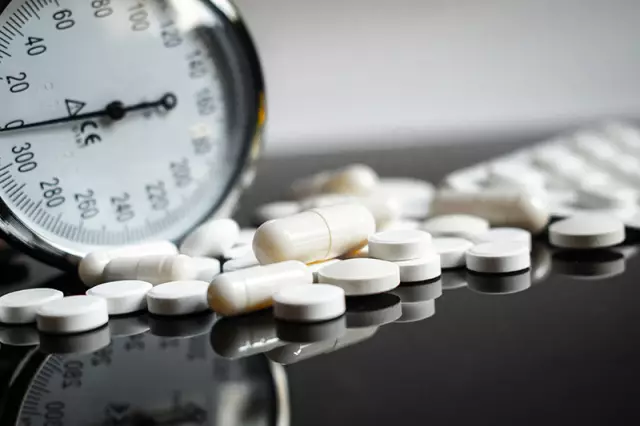- Author Rachel Wainwright [email protected].
- Public 2023-12-15 07:39.
- Last modified 2025-11-02 20:14.
Prothionamide
Protionamide: instructions for use and reviews
- 1. Release form and composition
- 2. Pharmacological properties
- 3. Indications for use
- 4. Contraindications
- 5. Method of application and dosage
- 6. Side effects
- 7. Overdose
- 8. Special instructions
- 9. Application during pregnancy and lactation
- 10. Use in childhood
- 11. For violations of liver function
- 12. Use in the elderly
- 13. Drug interactions
- 14. Analogs
- 15. Terms and conditions of storage
- 16. Terms of dispensing from pharmacies
- 17. Reviews
- 18. Price in pharmacies
Latin name: Protionamide
ATX code: J04AD01
Active ingredient: protionamide (protionamide)
Producer: Pharmasintez JSC (Russia), Valenta Pharm JSC (Russia), Sentiss Pharma Pvt. Ltd (India), Lincoln Pharmaceuticals Ltd. (India), Simpex Pharma Pvt. Ltd. (India), OOO Ozone (Russia)
Description and photo update: 10.07.2018

Prothionamide is an anti-tuberculosis drug.
Release form and composition
Dosage form - film-coated tablets: round, biconvex; at the break, two layers stand out: a shell - from yellow to yellow-orange and a yellow core (10 pcs. in blister packs / blisters, in a cardboard box 1-5, 10, 50 or 100 packs / blisters; 50 pcs. in blister contoured packages, in a cardboard bundle of 1-5 or 10 packs; 50, 100, 500, 1000 or 3000 pcs. in polyethylene bags, in a plastic bottle 1 package; 10, 20, 30, 40, 50, 100 or 1000 pieces in polymer cans, in a cardboard box 1 can).
Active ingredient in 1 tablet: protionamide - 250 mg.
Due to the presence of a large number of manufacturers, the composition of the auxiliary components and the film shell varies significantly. Other packaging options are also possible.
Pharmacological properties
Pharmacodynamics
Prothionamide is a synthetic antibacterial drug, a derivative of isonicotinic acid, belongs to the group of anti-tuberculosis drugs of the second row. It is a blocker of the synthesis of mycolic acids, the most important structural component of the MBT cell wall (mycobacterium tuberculosis). Prothionamide has the inherent properties of antagonists of nicotinic acid; in high concentrations, it disrupts protein biosynthesis in a microbial cell.
Prothionamide is effective against MBT resistant to first-line anti-tuberculosis drugs. It exhibits a bacteriostatic effect (the activity of which increases in an acidic environment) in relation to intra- and extracellular Mycobacterium tuberculosis of rapid / slow reproduction. In high concentrations, it affects Mycobacterium leprae, as well as some atypical mycobacteria. In the foci of specific inflammation, it potentiates phagocytosis.
In the process of tuberculosis therapy, resistance of microorganisms quickly develops, their complete cross-resistance to ethionamide is noted. Prothionamide inhibits the development of resistance to other anti-tuberculosis drugs, while ethionamide is better tolerated.
Pharmacokinetics
Prothionamide is rapidly absorbed in the gastrointestinal tract (gastrointestinal tract), Cmax (maximum concentration) in blood plasma is reached 2-3 hours after oral administration.
The substance penetrates both healthy and pathologically altered tissues: serous / purulent pleural effusion, foci of tuberculosis and cavities in the lungs, cerebrospinal fluid with meningitis.
The drug is metabolized in the liver, one of its metabolites, sulfoxide, exhibits tuberculostatic activity.
It is excreted by the kidneys and with bile (including 15-20% unchanged).
Indications for use
According to the instructions, Protionamide is used for the combined treatment of pulmonary / extrapulmonary forms of tuberculosis, with resistance to therapy with first-line anti-tuberculosis drugs or their poor tolerance, in order to stop infiltrative, ulcerative and exudative processes.
Contraindications
Absolute:
- acute gastritis;
- peptic ulcer of the stomach and duodenum;
- erosive and ulcerative colitis;
- acute hepatitis;
- cirrhosis of the liver;
- chronic alcoholism;
- pregnancy and lactation period;
- childhood;
- individual hypersensitivity to any components.
Relative contraindications for which Protionamide is used with caution: severe liver failure, diabetes mellitus.
Instructions for the use of Protionamide: method and dosage
Prothionamide is intended for oral administration and should be taken after meals.
Recommended dosage:
- adult patients: 250 mg 3 times a day; with good tolerance - 2 times a day, 500 mg; therapeutic daily dose of 500-1000 mg;
- children: at the rate of 10-20 mg / kg of body weight per day.
For patients over 60 years old and patients weighing less than 50 kg, the maximum daily dose should not exceed 750 mg (the preferred dosage is 2 times a day, 250 mg).
The duration of the therapeutic course is 8-9 months.
Side effects
Possible side effects of Protionamide:
- digestive system: nausea / vomiting, loss of appetite; dryness, hypersalivation, or a metallic taste in the mouth (quickly disappear after discontinuation of the drug); often - increased activity of hepatic transaminases; rarely - severe hepatic dysfunction with signs of hepatitis / jaundice (hepatotoxicity depends on the degree of liver failure, for example, due to liver damage as a result of alcoholism). The likelihood of side effects increases with the combined use of the drug with pyrazinamide, isoniazid, rifampicin;
- CNS (central nervous system): insomnia, anxiety, depression, agitation; rarely - drowsiness, asthenia, dizziness, headache; in isolated cases - optic neuritis, paresthesia, peripheral neuropathy; the enhancement of these side effects of protionamide can be facilitated by the simultaneous intake of other anti-tuberculosis drugs acting on the central nervous system (isoniazid, cycloserine), and alcohol;
- cardiovascular system: orthostatic hypotension, tachycardia;
- endocrine system: sometimes - hypoglycemia in patients with diabetes mellitus, gynecomastia in men; rarely - decreased potency, decreased thyroid function (hypothyroidism), menstrual irregularities;
- allergic reactions: rarely - skin rash; in some cases - pellagra-like reactions (a combination of skin manifestations and disorders of the central nervous system).
Overdose
Overdose symptoms are encephalopathy, abnormal liver function, pellagra-like skin reactions.
It is recommended to cancel the drug and conduct symptomatic therapy.
special instructions
Reception of protionamide must be started after testing the sensitivity of pathogenic microflora to it. The dose of the drug is determined individually based on the patient's susceptibility and the tolerance of the substance.
The combined use of the drug with alcohol should be avoided due to the increased toxic effect of alcohol, which increases the danger of CNS depression.
Combined use with isoniazid and cycloserine requires special attention due to possible mental disorders.
In connection with the constant use of prothionamide in combination with other anti-tuberculosis drugs, regular monitoring of the following laboratory parameters is required: serum transaminases, gamma-glutamyl transferase and alkaline phosphatase.
Patients with diabetes mellitus need to control the blood glucose level at least 1 time per month and, if necessary, adjust the dose of insulin or hypoglycemic agents for oral administration.
The development of skin reactions may be a manifestation of the symptoms of pellagra-like side effects, which should be regarded as the need to discontinue the drug.
In order to reduce the risk of side effects, it is recommended to combine the intake of prothionamide with pyridoxine (vitamin B 6) in a daily dose of 150-300 mg.
Application during pregnancy and lactation
Due to the penetration of prothionamide through the placental barrier, its use during pregnancy is contraindicated.
Breastfeeding during drug therapy should be discontinued.
Pediatric use
Prothionamide in pediatric practice should be used in accordance with the prescription of the attending physician and taking into account the manufacturer's recommendations.
Different pharmaceutical companies define age limits as follows: under 3, under 14 or under 18.
It is recommended to determine the daily dose of the drug for children at the rate of 10-20 mg per kg of body weight.
For violations of liver function
Protionamide is used with caution in severe hepatic impairment. The drug is contraindicated in patients with acute hepatitis and liver cirrhosis.
Use in the elderly
Patients over 60 years of age are prescribed protionamide in a dose of 500 mg per day, divided into 2 doses, the maximum daily dose is 750 mg.
Drug interactions
Isoniazid, pyrazinamide, cycloserine and other anti-TB drugs are compatible with prothionamide.
It is required to take into account that isoniazid increases the plasma concentration of prothionamide.
Isoniazid, rifampicin and pyrazinamide exhibit an additive hepatotoxic effect with protionamide.
Synergism of action on the central nervous system is observed with the combined use of isoniazid and cycloserine with protionamide.
Prothionamide enhances the depressing effect of alcohol on the central nervous system.
Occasionally, taking prothionamide may require lowering the dose of insulin or oral hypoglycemic drugs.
Analogs
The analogues of Prothionamide are Protomid, Petekha, Prothionamid-Acri, Protubutin, Kombitub-Neo, Protiokomb, etc.
Terms and conditions of storage
Keep the drug out of the reach of children.
Depending on the manufacturer (auxiliary composition of the tablets), the maximum storage temperature varies from 25 to 30 ° C.
The expiration date and storage conditions should be seen on the packaging.
Terms of dispensing from pharmacies
Dispensed by prescription.
Reviews about Protionamide
Since the drug is used only in case of ineffectiveness of anti-tuberculosis drugs of the first row, that is, quite infrequently, there are practically no reviews of Protionamide. In the available reviews, patients describe the effectiveness of the drug, noting along with it side effects, the most common of which is nausea.
The price of Prothionamide in pharmacies
Estimated price of Prothionamide tablets 250 mg for 50 pcs. in the package ranges from 350 to 390 rubles.

Anna Kozlova Medical journalist About the author
Education: Rostov State Medical University, specialty "General Medicine".
Information about the drug is generalized, provided for informational purposes only and does not replace the official instructions. Self-medication is hazardous to health!






